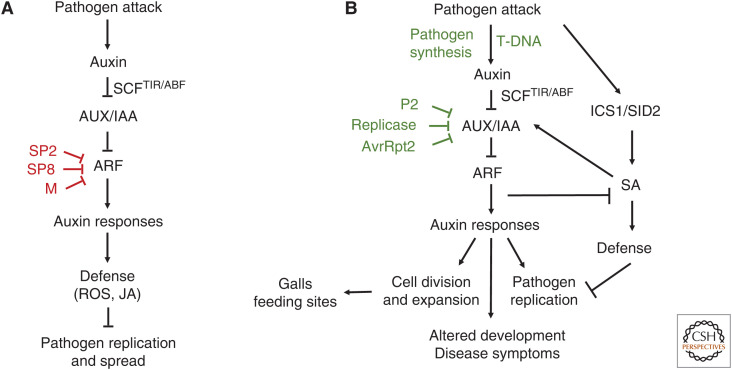Figure 1.
Host auxin signaling during plant–pathogen interactions. (A) Infection by some necrotrophic pathogens, such as Alternaria and Rhizoctonia, and some plant viruses stimulates auxin signaling, resulting in activation of defenses that inhibit pathogen replication and spread. The SP2 protein from rice stripe virus, the SP8 protein from Southern rice black-streaked dwarf virus, and the M protein from rice stripe mosaic virus interact with different regions of OsARF17 and modulate its function, thereby inhibiting activation of auxin-dependent defenses (Zhang et al. 2019, 2020). (B) Biotrophic pathogens, such as Pseudomonas spp., Agrobacterium tumefaciens, and Pantoea agglomerans, stimulate auxin signaling to promote disease. Stimulation of auxin signaling can occur at many points in the signaling process including auxin synthesis by the pathogen (Kunkel and Harper 2018). Enhanced auxin signaling can promote production of disease symptoms, development of galls and feeding sites, and/or suppress salicylic acid (SA)-mediated defenses. SA-mediated defense signaling and auxin signaling are mutually antagonistic (Wang et al. 2007; Cui et al. 2013). Several pathogens have evolved virulence factors to promote auxin signaling. The Pseudomonas syringae T3S-effector protein AvrRpt2 enhances auxin sensitivity by promoting degradation of AUX/IAA proteins (Cui et al. 2013). The 126/183 kDa replicase protein from tobacco mosaic virus inhibits PAP1/IAA16 function (Padmanabhan et al. 2006), and the P2 protein from rice dwarf virus targets OsIAA10 and prevents its degradation (Jin et al. 2016). Virulence factors shown in red inhibit auxin signaling. Virulence factors shown in green stimulate auxin responses. (SCF) Skp, Cullin, F-box ubiquitin protein ligase complex, (TIR/AFB) TRANSPORT INHIBITOR RESPONSE1/AUXIN F-BOX, F-box proteins (auxin coreceptor), (AUX/IAA) AUXIN/INDOLE ACETIC ACID (transcriptional repressors), (ARF) AUXIN RESPONSE FACTOR (transcription factor), (ROS) reactive oxygen species, (JAs) jasmonates, (ICS1/SID2) isochorismate synthase (SA synthesis), (SA) salicylic acid.

